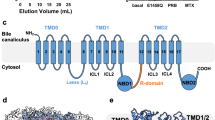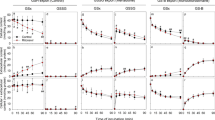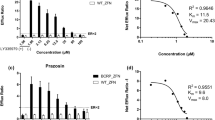Abstract
Multidrug resistance-associated protein 1 (MRP1) was originally shown to confer resistance of human tumor cells to a broad range of natural product anticancer drugs. MRP1 has also been shown to mediate efflux transport of glutathione and glucuronide conjugates of drugs and endogenous substrates. An ortholog of MRP1 in the mouse has been cloned and characterized. Significant functional differences between murine and human MRP1 have been noted. Since drug disposition and pharmacology studies often are conducted in rats, there is a need to clone and characterize the rat ortholog of MRP1. We isolated a rat MRP1 (rMRP1) cDNA from rat brain astrocytes, characterized its coding sequences, and verified the transport activity of the protein expressed in MRP1 cDNA-transfected Madin-Darby canine kidney (MDCK) cells. Our results showed that rMRP1 has a coding sequence of 4599 bp, which predicts a polypeptide of 1533 amino acids with an apparent molecular weight of 190 kd by Western immunoblot analysis. rMRP1-transfected MDCK cells are capable of efflux transport of a fluorescent MRP1 marker-calcein-that is inhibitable by known MRP1 inhibitors, indomethacin, and MK571. Sequence analysis indicates that rMRP1 is more closely related to mouse MRP1 than human MRP1.
Similar content being viewed by others
References
Cole SP, Bhardwaj G, Gerlach JH, et al. Overexpression of a transporter gene in a multidrug-resistant human lung cancer cell line. Science. 1992;258:1650–1654.
Kool M, de Haas M, Scheffer GL, et al. Analysis of expression of cMOAT (MRP2), MRP3, MRP4, and MRP5, homologues of the multidrug resistance-associated protein gene (MRP1), in human cancer cell lines. Cancer Res. 1997;57:3537–3547.
Stride BD, Valdimarsson G, Gerlach JH, Wilson GM, Cole SP, Deeley RG. Structure and expression of the messenger RNA encoding the murine multidrug resistance protein, an ATP-binding cassette transporter. Mol Pharmacol. 1996;49:962–971.
Paul S, Belinsky MG, Shen H, Kruh GD. Structure and in vitro substrate specificity of the murine multidrug resistance-associated protein. Biochemistry. 1996;35:13647–13655.
Stride BD, Grant CE, Loe DW, Hipfner DR, Cole SP, Deeley RG. Pharmacological characterization of the murine and human orthologs of multidrug-resistance protein in transfected human embryonic kidney cells. Mol Pharmacol. 1997;52:344–353.
Zhang DW, Cole SP, Deeley RG. Identification of a nonconserved amino acid residue in multidrug resistance protein 1 important for determing substrate specificity: evidence for functional interaction between transmembrane helices 14 and 17. J Biol Chem. 2001;276:34966–34974.
Zhang DW, Cole SP, Deeley RG. Identification of an amino acid residue in multidrug resistance protein 1 critical for conferring resistance to anthracyclines. J Biol Chem. 2001;276:13231–13239.
Hirrlinger J, Konig J, Keppler D, Lindenau J, Schulz JB, Dringen R. The multidrug resistance protein MRP1 mediates the release of glutathione disulfide from rat astrocytes during oxidative stress. J Neurochem. 2001;76:627–636.
Cattin MC, Guizzetti M, Costa LG. Effects of ethanol on calcium homeostasis in the nervous system implications for astrocytes. Mol Neurobiol. 1999;19:1–24.
Yang ZP, Woodahl EL, Wang XY, Bui T, Shen DD, Ho RJY. Development of a semi quantitative RT-PCR method to characterize full-length MDR1 message levels. Biotechniques. In press, 2002.
Tusnady GE, Simon I. The HMMTOP transmembrane topology prediction server. Bioinformatics. 2001;17:849–850.
Hipfner DR, Deeley RG, Cole SP. Structural, mechanistic and clinical aspects of MRP1. Biochim Biophys Acta. 1999;1461:359–376.
Roller A, Bahr OR, Streffer J, et al. Selective potentiation of drug cytotoxicity by NSAID in human glioma cells: the role of COX-1 and MRP. Biochem Biophys Res Commun. 1999;259:600–605.
Bakos E, Evers R, Calenda G, et al. Characterization of the amino-terminal regions in the human multidrug resistance protein (MRP1). J Cell Sci. 2000;113(24):4451–4461.
Author information
Authors and Affiliations
Corresponding author
Additional information
Published: September 30, 2002
Rights and permissions
About this article
Cite this article
Yang, Z., Li, C.S.W., Shen, D.D. et al. Cloning and characterization of the rat multidrug resistance-associated protein 1. AAPS J 4, 15 (2002). https://doi.org/10.1208/ps040315
Received:
Accepted:
Published:
DOI: https://doi.org/10.1208/ps040315




